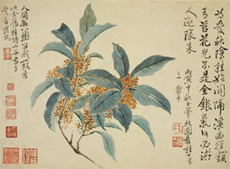Raymond Tang
Former Assistant Curator I (Xubaizhai), Hong Kong Museum of Art
2008
 |
 |
|
| Yun Shouping (1633-1690), Wang Hui (1632-1717) Landscapes and flowers (leaf 1) |
Wen Qiqiu (1862-1941) Flowers (section) 1909 |
Almost identical, the two flower paintings, one by Early Qing master Yun Shaoping (1633-1690) as a leaf of the album entitled "The One and Only", and one by late Qing Guangdong painter Wen Qiqiu (1862-1941) as a part of his floral handscroll, were painted separately.
"The One and Only" album, embracing 4 leaves of flowers by Yun and 4 landscapes by Wang Hui (1632-1717) was done in 1685-1686, and then, brought to Guangdong Province around the 1850s. Initially it was owned by the wealthy Huang family in Nanhai County and later passed on to another Nanhai collector Huang Jidu. After Huang's death, the 4 leaves of flowers was sold to the Zhong family who further offered them to Xin Fangsu, a Shunde collector in 1905. Xin reassembled the album by paying an exorbitant cost to purchase the 4 landscapes from a rich man named Wang Shizhi. However, Xin was dispossessed of his collection under financial hardship. The album was traded among Guangzhou collectors like He Guanwu, Mo Yuanzan and then brought to Hong Kong in the 1950s to 1960s. Finally, it was acquired by Low Chuck Tiew and added into his notable Xubaizhai Collection which was an invaluable legacy bequeathed to the Museum.
Inheriting the flower painting style of Song Guangbao and inspired by the art of Yun Shaoping, the painter Wen Qiqiu of Shunde had spent a decade assiduously searching and studying Yun's works in local collections. The reference for creating this handscroll in 1909 might be drawn from "The One and Only" album kept by Wen's county man, the collector Xin Fangsu at this time. It is truly a legend that the two "flowers" have got together in the Museum's collection a century later!



